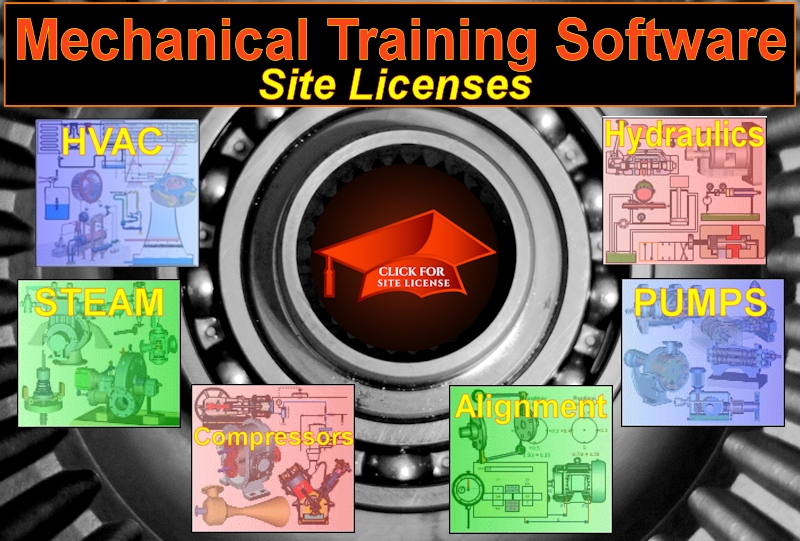
Mechanical Skills: Rotating Equipment : Pumps Assessment
Mechanical Skills: Rotating Equipment : Pumps :
Rotating equipment intermediate mechanical assessment test with 13 questions. A lot of pump questions. Also, advice on sump pump installations and problems.
Please consider our training while here ...

See our Mechanical Engineering Courses to learn more. From pumps to compressors and even HVAC.
Mechanical Skills: Rotating Equipment : Pumps test details:
( 13 Questions )
Rotating equipment intermediate mechanical assessment Test with 13 questions. A lot of pump questions.
If you found this test via a search, please be advised the above test assesses one's experience working with pumps. For those with lesser pump experience, the sump pump installation and problems sections below are helpful.
Sump Pump Installation and Problems
Installing a Sump Pump:
Installing A Typical Basement Sump Pump
Sump pumps are generally low-cost. But experience tells us that it's not always a good idea to economize when buying a pump. The logical thing to do is buy the best quality pump that your budget will allow.
Typically, a sump pump will have a threaded discharge port. Thread a PVC male adapter into the port and tighten it until it feels snug. Glue a short-pressure pipe PVC riser into the male adapter using PVC cement. The length of the riser will depend on the depth of the sump. The goal is to bring the riser just above the top of the sump.
Before setting the pump in the pit, bind the electrical cord and level switch cord to the riser with plastic electrical ties. Carefully lower the pump into the pit liner.
When the pump is resting on the bottom, check the float position. Locate the pump so the float is a hand width away from the sump wall so it can move up and down without interference. Then, install the sump lid over the riser. If necessary, bore a hole for the riser to fit.
With the pump in place, install a check valve (non-return valve) on the riser the same size as the pipe diameter. This valve is essential because it keeps the pump motor from burning out. Without a check valve, water pumped up the riser would fall back into the pit each time the pump stops. This small amount of water is often enough to reactivate the pump, causing it to run again for a few moments and shut off again. The constant on/off sequence can quickly wreck a pump.
The check valve can come with rubber couplings and hose clamps or with screwed connections. Be sure to position the valve with the arrow indicating the flow direction pointing up.
If a lot of grit goes through the pump, a non-return valve will get worn or not seat properly when it closes. In such cases, it is necessary to use two float switches set at different levels. The lower one turns the pump off, and the higher one turns the pump on. When the liquid runs back down the pipe, there will not be enough to turn on the high-level switch.
Continue the riser upward from the non-return valve and install an easily reachable ball valve. Finally, take the discharge line out of the basement using a suitable route. Fix the discharge pipe to a firm location with screwed clamps, solidly supporting it every meter to a meter and a half.
Sump Pump Problems:
A few problems exist with sump, small submersible, and bilge pump applications you should be aware of. These points will help you in troubleshooting sump pump problems, maybe even avoid some problems.
- If the pump suction port is blocked with rubbish like rags, cardboard, timber, encrustation, and the like, the pump will not get enough liquid and will stop pumping. When liquid arrives, it will produce a surging discharge and be rapidly pumped away. The risk here is dry-running the pump and destroying seals and impeller shafts.
- Cavitation happens when a pump draws a deep vacuum and causes the liquid to boil. In that case, it tries to pump out the vapor, and no liquid flows. Dry running is also a risk here too.
- If enough sludge, rubble, dirt, and the like build up at the bottom of the Sump to block the pump inlet, it must be first removed before starting the pump. It may be necessary to clean the sump out regularly if build-up is likely. An example is roadway silt, dust, and branches running into sumps and settling around the pump. If sediment and debris are a natural, regular occurrence, installing a sump pump designed to handle solids may be better. These are also known as ‘trash’ pumps.
- Beware of the position of the discharge line outlet. If it exceeds the pumped liquid level, ensure an air gap between the pipe outlet and the discharged liquid; otherwise, it may siphon back into the sump. If the discharge pipe outlet is lower than the pump, it can siphon the sump through the pipe uncontrolled and unmonitored.
- The on/off float can get snagged in rubble and rubbish. Depending on the position in which it is caught, the pump will either not start or not stop.
- Where the liquid is too hot and the motor will not be sufficiently cooled, it is best to install a column pump.
- If the liquid is corrosive to standard sump pump construction materials, it is possible to get column pumps made of more resistant metals and plastics.
- If the pump is down deep, connect a cable to be pulled up with certainty. If you only have the discharge pipe or hose to haul up the pump, it may not be strong enough or too awkward to use. Ensure the cable is well fixed to the pump and cannot pull loose.
- Ensure the pump can lift the liquid to the height you need, plus the additional height required for piping friction losses inside the discharge pipe.
- If a lot of sludge settles at the bottom of the Sump, either change it to a heavy-duty ‘trash’ pump or suspend the sump pump off the bottom and allow the sludge to build up. Ensure the Sump is cleaned out regularly before it covers the pump suction.
Published:
